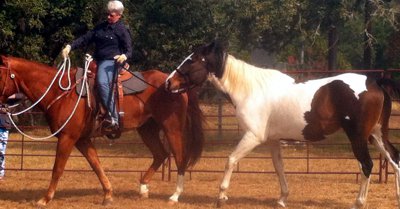The Equine Stomach
I was able to attend a fantastic lecture on the equine stomach at the 2003 AAEP convention. A. M. Merritt, DVM, MS shared the latest research on this topic. Here are just a few of the things I discovered. This information is particularly valuable in understanding why the horse is so prone to gastric ulcers and why response to drug therapy can be variable.
Feedstuffs tend to layer in the equine stomach and the layers vary in their pH balance, 7 is neutral, with 1 being most acid and 14 being most alkaline. . Coarser materials form a mat in the upper portion of the stomach and mix with saliva to keep the pH in that region around 6 to 7. Medium-density feedstuffs are located in the middle zone of the stomach, and this area has a pH of 4 to 5. High density fluids are in the lower portion of the stomach and the pH is 1 to 2.
The lower portion of the stomach is the glandular portion which is protected from acid by a mucous coating. The upper non-glandular or squamous portion of the stomach is not intended to be exposed to stomach acid. Hydrochloric acid is secreted continually by the parietal cells in the gastric glands which are located in the lower portion of the stomach.
The discovery of this layering effect helps explain why exercise tends to increase the frequency of gastric ulcer formation in horses. Monitors implanted in working horses revealed the contractions of abdominal muscles forced the lower pH liquids from the lower portions of the stomach up through the coarser feedstuff layers, exposing the non-glandular portion to the corrosive acids. Even abdominal muscle contraction secondary to anxiety caused the same reaction.
Acid secretion is up or down, and is regulated by food intake. The stomach acts as its own pH meter. It is worth going into some detail as to how this process works so you can understand how different drugs affect stomach acid in the equine. Histamine is a major player in the release of HCL by the parietal cells. By blocking the H2 (histamine 2) receptors, release of stomach acid can be suppressed.
Within the pyloric gland mucosa, unique cell types which are located very close to each other constantly “test” the pH of the stomach and react in such a way as to keep the pH in the correct range.
Antihistamines which block H2 receptors are able to block, at least in part, the release of HCL. Examples of these types of drugs include Cimetidine and Ranitadine. For years these drugs were the mainstay for ulcer treatment in horses. Unfortunately, they were inconsistent in effectiveness because the parietal cells are so sensitive to histamine that frequent large doses were required to control acid secretion. The parietal cells were also able to respond directly to stimulation of the vagus nerve.
The current drug of choice for ulcers in horses is GastrogardT (omeprazole). This drug is a proton pump inhibitor, which means it acts to block acid secretion after all possible stimulators have acted. Like other anti-ulcer drugs, GastrogardT does not address the underlying cause of equine ulcers. This drug can be very effective in treating ulcers but symptoms will often return when treatment is discontinued.
A holistic approach to treating and preventing equine ulcers would include keeping stress to a minimum so horses would not constantly be contracting their abdominal muscles. Feeding free choice hay helps to keep the fibrous mat layer intact in the stomach. Natural products such as aloe vera gel and the herb, slippery elm, can help protect the stomach tissue by forming a gel-like barrier. Feeding a high fat, low carbohydrate feed such as Equine seniorT is much better than high grain diets. Grain is digested in the stomach and increases the production of acid. If one assumes that exercise is going to cause some contact of the acid with sensitive squamous cells, then it make sense to provide nutritional support which maximizes the healing of tissues. New Earth’s blue green algae is one product which gives the body natural vitamins, minerals and antioxidants to support healthy tissues. Another good product to support health and healing is Noni Juice. This product contains natural enzymes which are needed in larger amounts when the body is under stress. www.tahitiannoni.com/rodeo I feel all performance horses benefit from these natural products which support health. Based on an understanding of how the equine stomach works, some degree of pathology is almost inevitable in our working horses. Why wait for symptoms to develop?
About the Author
Madalyn Ward, DVM, owns Bear Creek Veterinary Clinic in Austin, Texas. She is certified in Veterinary Homeopathy and Equine Osteopathy.
Memberships include American Veterinary Medical Association, American Association of Equine Practitioners, American Holistic Veterinary Medical Association, Texas Veterinary Medical Association and the Academy of Veterinary Homeopathy.
She has authored several books and publishes at her blog.
